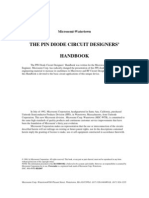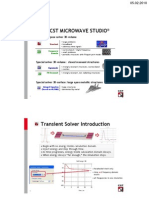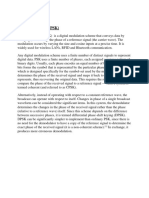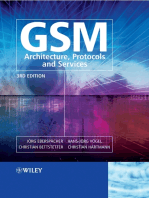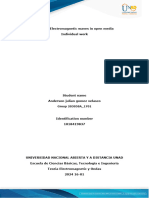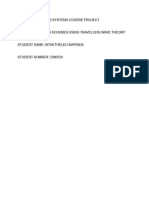CST STUDIO SUITE Help PDF
CST STUDIO SUITE Help PDF
Uploaded by
Md Ibrahim Khalil SalmanCopyright:
Available Formats
CST STUDIO SUITE Help PDF
CST STUDIO SUITE Help PDF
Uploaded by
Md Ibrahim Khalil SalmanOriginal Description:
Original Title
Copyright
Available Formats
Share this document
Did you find this document useful?
Is this content inappropriate?
Copyright:
Available Formats
CST STUDIO SUITE Help PDF
CST STUDIO SUITE Help PDF
Uploaded by
Md Ibrahim Khalil SalmanCopyright:
Available Formats
Sources and Boundary Condition Problem Handling
file:///C:/Program Files/CST STUDIO SUITE 2012/Online Help/mergedP...
Sources and Boundary Condition Problem Handling
This page contains a list of the most important warning and error messages in the context of source, boundary and material modeling together with a detailed explanation of the meaning and proposal for handling and resolution.
Contents
Excitation sources Waveguide ports Multipin ports Floquet ports Source configuration Materials Boundaries Lumped Network Elements
Excitation sources
Waveguide ports Port number "xxx" is completely filled with metal. Maybe the background material is defined as PEC? All degrees of freedom inside the port plane lie inside metal material, so that no mode pattern can be calculated. Please check whether the background material is defined as PEC or the port is located inside a metal object. Some higher order propagating modes at port "xxx" are not considered in time domain calculation. This possibly leads to an inaccurate energy balance. Consider to increase the number of modes or decrease the upper frequency limit. In case of a multi-conductor port usually TEM or QTEM modes are of interest. Depending on the dimension of the waveguide port and the upper limit of the global frequency range, there might also occur higher order propagating modes in addition. Usually this is not intended and these modes can be stopped from propagating by lowering the upper frequency limit. In principle it is also possible to reduce the port size, but this has to be done very carefully in order to still sufficiently cover the mode patterns of the relevant TEM and QTEM modes. In case that the higher order propagating modes are intended as e.g. box modes, the number of modes should be increased to consider these modes correctly for simulation. Some higher order evanescent modes at port "xxx" are not sufficiently decaying concerning the structure dimension. This possibly leads to an inaccurate energy balance. Consider to increase the number of modes or decrease the upper frequency limit. In case of a multi-conductor port usually TEM or QTEM modes are of interest. Depending on the dimension of the waveguide port and the upper limit of the global frequency range, there might also occur higher order evanescent modes. Usually these modes have no important influence on the simulation, because they are decaying over a very small distance. However, in case that their damping constant is small their influence cannot be neglected anymore. By lowering the upper frequency limit these modes will be damped more intensively. In principle it is also possible to reduce the port size, but this has to be done very carefully in order to still sufficiently cover the mode patterns of the relevant TEM and QTEM modes. In case that the higher order evanescent modes are intended as e.g. box modes, the number of modes should be increased to consider these modes correctly for simulation. At least one propagating mode at port "xxx" is not considered in the time domain calculation! (At least one mode shares the same beta with considered mode(s) -> degeneration) It might be better to increase the number of modes at port "xxx". "nnn" degenerated mode(s) at port "xxx" is/are not considered in time domain calculation! It might be better to increase the number of modes at port "xxx". This warning is shown when some propagating TE or TM modes are not considered in the simulation. Usually this is not intended and the modes could be taken into account by increasing the number of modes. In case of missing degenerated modes (sharing the same propagation constant) this is even more important to provide an accurate simulation result. The first mode at inhomogeneous port "xxx" is hybrid. This could lead to an inaccurate energy balance. Please check your structure. Hybrid modes exist at inhomogeneous port "xxx". This could lead to an inaccurate energy balance. Please check your structure. When the calculated field pattern at the port is a six-component mode, which can not be decomposed into two or more degenerated modes, this warning will be generated. Typically this is caused by incorrect structure modeling such as a microstrip transmission line where the ground plane does not intersect the port. Please check your port setup. There exist non-(Q)TEM modes for the inhomogeneous port "xxx". This may lead to an inaccurate energy balance. Consider to decrease the upper frequency limit. Although expected for a multiconductor port, one or more modes could not be classified as (Q)TEM at some frequency point. This usually happens at higher frequencies when longitudinal field components become stronger. The modes are classified as TE/TM or hybrid in this case. Consider to decrease the upper frequency limit. The inhomogeneous port "xxx" shows a strong dispersive behavior. Please increase the number of modes. At inhomogeneous ports it is necessary to track the mode pattern over frequency in order to provide correct scattering parameters. However, this is only possible if the mode patterns vary not too much between the lower and upper frequency limit. Furthermore, mode propagation constants might interchange over frequency such that the corresponding mode cannot be found anymore. In this case it might be necessary to increase the number of modes. Inhomogeneous port accuracy enhancement: Port "xxx" shows a strong dispersive behavior which could lead to inaccurate S-parameter results. Please decrease the upper frequency limit. The inhomogeneous port accuracy enhancement can compensate errors introduced by frequency dependent mode patterns. However, this is only possible if the mode patterns vary not too much between the lower and upper frequency limit. If this warning is issued please consider decreasing the upper frequency limit or splitting the frequency range in higher and lower bands.
1 of 3
1/22/2013 11:08 PM
Sources and Boundary Condition Problem Handling
file:///C:/Program Files/CST STUDIO SUITE 2012/Online Help/mergedP...
Multipin ports Multipin port "xxx" is strongly inhomogeneous, i.e. the corresponding modes represent combinations of field patterns with different propagation properties. This may lead to an inaccurate energy balance. At inhomogeneous multipin ports QTEM modes are combined to satisfy the specified potential set definition. If the propagation constants of the modes differ too much they cannot be considered as degenerate anymore and they should not be combined. Some (Q)TEM modes were not found on port "xxx". Consider to increase the mode calculation frequency. To create a multpin port mode that satisfies the specified potential settings it is necessary to linearly combine the existing degenerated TEM or QTEM modes. If the mode calculation frequency is very low not all modes may be available. Consider increasing the mode calculation frequency in the specials dialog of the time domain solver or adjusting the global frequency range. Some (Q)TEM modes are not considered at port "xxx". This may lead to an inaccurate energy balance. It is important that the number of defined potential sets equals the number of degenerated QTEM or TEM modes in the waveguide. If not a large part of the field may propagate in the unconsidered mode patterns. The waveguide port boundary still treats these fields internally but they will not contribute to the scattering matrix and may therefore lead to an inaccurate energy balance. The multipin potential settings on port "xxx" result in linearly dependent field patterns. Please note that the mode fields will be orthogonalized to ensure stability. The defined potential sets should result in linear independent field patterns, e.g. the even and odd modes in a three conductor port. Otherwise the fields at the port cannot properly be decomposed into mode amplitudes. Please check whether the potential set definition is meaningful or consider treating the port as single-ended. Multipin port "xxx" calculates a zero mode pattern. Maybe your structure shows some unwanted electric cavities. Changing boundaries from electric to magnetic possibly solves this problem. This warning is shown when a multipin port area has some decoupled mode regions, so called cavities. This might happen either by an incorrect port setup or by electric transversal port boundary conditions which creates cavities between themselves and the outer port conductor. In the latter case changing the boundary conditions to magnetic can remove these unwanted cavities.
Floquet ports At least one propagating Floquet mode is not considered at port "xxx". Please increase the number of modes at this port. It is important to consider all propagating modes in the simulation, since those parts of the fields attributed to unconsidered modes will be reflected at the Floquet port boundary. This usually may lead to inaccurate S-parameters. Please include all propagting modes by increasing the number of modes considered at the Floquet port in the Settings for Floquet Boundary dialog.
Materials
The material "xxx" has a very high conductivity for the given mesh. It may be better to use a lossy metal type for this material. The material "xxx" has a very low conductivity for the lossy metal model. It may be better to use a normal type for this material. In order to simulate conductive material, the mesh has to be refined such, that the field variation (e.g. skin depth) is sufficiently discretized. This might lead to an extremely fine mesh representation for highly conductive materials. For these kind of materials the "lossy metal" model should be applied, which takes into account the skin effect without refining the mesh. However, if the skin depth is larger than the metal thickness and a radiation effect through the metal is of importance, the lossy metal model cannot be used anymore and type "normal" should be selected. This is also true for materials with very low conductivity where the "normal" material type offers a more accurate simulation result than the "lossy metal" surface model. The two warning messages indicate which material type selection should be preferred. Please find a more detailed description on these and other material types on the Material Overview page.
Boundaries Lumped Network Elements
At least one end point of "xxx" is not connected to any good conductor. At least one end point of the following discrete ports or lumped elements is not connected to any good conductor: ... Some discrete ports or lumped network elements were found which are not connected to any good conductor, for instance "floating" some distance away from a conductor due to modelling tolerances. Especially at low frequencies, results then can differ from what is expected, since the connection to the remaining three-dimensional representation of the circuit is uncertain. Please zoom in to inspect the connectivity of the network elements, and create them again if necessary (preferrably pick a part of the conductors the network element should be connected to.) The check for floating elements considers the end points of edge lumped network elements. This also the case for the face ports and face lumped network elements: they have an alternative edge lumped network element associated with them which is used by solvers that do not support the face type lumped network elements. For the sake of simplicity and performance of the connectivity check, these associated edges will be used for the face lumped network elements. For each of their end points, the check tries to find a conductor body that contains the point. PEC and lossy metal solids are considered as good conductors, as well as normal materials with a conductivity higher than 1000 S/m. Face lumped elements are only supported over rectangular, cylinder-barrel or radial surfaces. The error message is displayed if the shape of the face lumped network elements is not supported or not recognized, for instance due to modelling accuracy. Rectangular, cylinder-barrel and radial lumped network elements are supported. They are illustrated by the first three lumped network elements in the picture below. Please delete and re-create the lumped network elements so that their shape is either rectangular, cylinder-barrel, radial like, or use straight edge lumped network elements.
2 of 3
1/22/2013 11:08 PM
Sources and Boundary Condition Problem Handling
file:///C:/Program Files/CST STUDIO SUITE 2012/Online Help/mergedP...
from left to right: a rectangular discrete port, a cylinder-barrel lumped network element, a radial discrete port, a lumped network element of different shape
3 of 3
1/22/2013 11:08 PM
You might also like
- CST Application Note AntennaDocument34 pagesCST Application Note AntennaNgô Văn ĐứcNo ratings yet
- AG312 Pin Diode PDFDocument18 pagesAG312 Pin Diode PDFtuwinnerNo ratings yet
- HFSS Floquet PortsDocument44 pagesHFSS Floquet PortsKenny PhamNo ratings yet
- 570914000AntennaArray CST MWS - SimulationDocument9 pages570914000AntennaArray CST MWS - SimulationkaranNo ratings yet
- FEKO. Script ExamplesDocument182 pagesFEKO. Script ExamplesLaz GsodfjxNo ratings yet
- Brochure EM3DS 12Document2 pagesBrochure EM3DS 12dmfa061No ratings yet
- P-I-N Diode HandbookDocument137 pagesP-I-N Diode HandbookChangjian LiNo ratings yet
- In CST To Choose A Point That Lies in The Center Between Two PointsDocument10 pagesIn CST To Choose A Point That Lies in The Center Between Two PointsAlfredo DezoNo ratings yet
- Customized Post Processing Using The Result Template ConceptDocument13 pagesCustomized Post Processing Using The Result Template ConceptshochstNo ratings yet
- CST Microwave Studio: General Purpose Solver 3d-VolumeDocument30 pagesCST Microwave Studio: General Purpose Solver 3d-VolumeShuvashis DeyNo ratings yet
- CST S2 2014 Final WebDocument24 pagesCST S2 2014 Final WebaliNo ratings yet
- 2575 Circuitpro 1 5 Manual Version 1 0 EnglishDocument111 pages2575 Circuitpro 1 5 Manual Version 1 0 EnglishVictor Guachimbosa SantiagoNo ratings yet
- Antenna Design For UWB Radar Detection Application: Sohaib MaalikDocument42 pagesAntenna Design For UWB Radar Detection Application: Sohaib MaalikSaif KamalNo ratings yet
- MWL05 ManualDocument81 pagesMWL05 ManualMustafa SeçmenNo ratings yet
- EDICONChina2019 - (87) - Vye, David - Designing A Narrowband 28-GHz Bandpass Filter For 5G Applications PDFDocument41 pagesEDICONChina2019 - (87) - Vye, David - Designing A Narrowband 28-GHz Bandpass Filter For 5G Applications PDFkhyatichavdaNo ratings yet
- Miniaturized 90 Degree Hybrid Coupler Using High Dielectric Substrate For QPSK Modulator PDFDocument4 pagesMiniaturized 90 Degree Hybrid Coupler Using High Dielectric Substrate For QPSK Modulator PDFDenis CarlosNo ratings yet
- Photonic Crystal Cavities: Nanophotonics and Integrated OpticsDocument8 pagesPhotonic Crystal Cavities: Nanophotonics and Integrated OpticsMax Marcano CamposNo ratings yet
- 4 1 2 Uwb Antenne Simulation With CST Microwave StudioDocument24 pages4 1 2 Uwb Antenne Simulation With CST Microwave StudioUmair SaleemNo ratings yet
- ADS Tutorial 2Document4 pagesADS Tutorial 2Minh VuNo ratings yet
- Horn AntennaDocument6 pagesHorn Antennanaji1365No ratings yet
- Experiment 8 - AttenuatorDocument24 pagesExperiment 8 - AttenuatorswatagodaNo ratings yet
- Antenna Arrays Thesis-Mohammed - AlbannayDocument124 pagesAntenna Arrays Thesis-Mohammed - AlbannayDivya MokaraNo ratings yet
- DuplexerDocument7 pagesDuplexermanishbharti0786100% (2)
- D-Band Frequency Tripler For Passive Imaging - Final 13th JulyDocument4 pagesD-Band Frequency Tripler For Passive Imaging - Final 13th JulyTapas Sarkar100% (1)
- CST Thermal1Document16 pagesCST Thermal1Edison Andres Zapata OchoaNo ratings yet
- BERPerformanceofDecode and ForwardRelayingDocument5 pagesBERPerformanceofDecode and ForwardRelayingMOHIT YADAVNo ratings yet
- Complete Design of A Microstrip Line CouplerDocument6 pagesComplete Design of A Microstrip Line CouplerJoe MullerNo ratings yet
- 2.design of Vivaldi Antennas ThesisDocument83 pages2.design of Vivaldi Antennas ThesisAlteea MareNo ratings yet
- RF Power Amplifier TestDocument8 pagesRF Power Amplifier TestSudarsh Suresh MallayaNo ratings yet
- Recent Research Results by Using CST Microwave Studio at Antenna Lab., POSTECHDocument15 pagesRecent Research Results by Using CST Microwave Studio at Antenna Lab., POSTECHdevmaa2007No ratings yet
- MAT10 ManualDocument70 pagesMAT10 ManualDevLaxmanNo ratings yet
- Advanced HFSS Training The Field CalculatorDocument27 pagesAdvanced HFSS Training The Field CalculatorHFdzAlNo ratings yet
- Low Frequency Electro Magnetic Design and Simulation: CST em StudioDocument2 pagesLow Frequency Electro Magnetic Design and Simulation: CST em StudioTotostyle AmrNo ratings yet
- ADS Tut 3Document4 pagesADS Tut 3Jihong ParkNo ratings yet
- HP-ADS Tutorial 2015Document32 pagesHP-ADS Tutorial 2015Ahmad UsmanNo ratings yet
- RF Guideline Propagation Model TuningDocument57 pagesRF Guideline Propagation Model Tuningaqua_salmanNo ratings yet
- CST Application Note RfidDocument15 pagesCST Application Note RfidAbohicham AbhNo ratings yet
- An Introduction To HFSS OptimetricsDocument52 pagesAn Introduction To HFSS OptimetricsdhruvaaaaaNo ratings yet
- Transmitter and ReceiverDocument28 pagesTransmitter and ReceiverVinod NayyarNo ratings yet
- Speed FlexDocument10 pagesSpeed FlexkylegazeNo ratings yet
- Phase-Shift Keying (PSK)Document4 pagesPhase-Shift Keying (PSK)sandzzzcrazyNo ratings yet
- Antenna Array Beam-Steering in Post-Processing: CST Studio SuiteDocument10 pagesAntenna Array Beam-Steering in Post-Processing: CST Studio Suitejax almarNo ratings yet
- 6-2-4 CST EucDocument30 pages6-2-4 CST EucDo SonNo ratings yet
- Eetop - CN ESD Simulation Talk 5-2-2 CST Ugm 2011Document17 pagesEetop - CN ESD Simulation Talk 5-2-2 CST Ugm 2011Văn CôngNo ratings yet
- ADS Session1Document14 pagesADS Session1Văn CôngNo ratings yet
- GSM - Architecture, Protocols and ServicesFrom EverandGSM - Architecture, Protocols and ServicesRating: 1 out of 5 stars1/5 (1)
- Microwave Filters for Communication Systems: Fundamentals, Design, and ApplicationsFrom EverandMicrowave Filters for Communication Systems: Fundamentals, Design, and ApplicationsNo ratings yet
- Optical and Microwave Technologies for Telecommunication NetworksFrom EverandOptical and Microwave Technologies for Telecommunication NetworksNo ratings yet
- HFSS Wave Vs Lumped PortsDocument20 pagesHFSS Wave Vs Lumped PortsajitgNo ratings yet
- Transmission Logic CircuitsDocument6 pagesTransmission Logic CircuitsvenkateshNo ratings yet
- Port Tutorial Lump V WaveDocument11 pagesPort Tutorial Lump V WavePablo MontesNo ratings yet
- High PSRR Ldo ThesisDocument4 pagesHigh PSRR Ldo Thesisnibaditapalmerpaterson100% (1)
- Modeling Transformer Core Effects in OpenDSS PDFDocument13 pagesModeling Transformer Core Effects in OpenDSS PDFLucas GodoiNo ratings yet
- 6T SRAM OperationDocument5 pages6T SRAM Operationblahblahpoop9No ratings yet
- Polyfet Mtts2002notesDocument2 pagesPolyfet Mtts2002notesCatalin GeluNo ratings yet
- Doc2Document4 pagesDoc2Md Ibrahim Khalil SalmanNo ratings yet
- doc-4Document41 pagesdoc-4Md Ibrahim Khalil SalmanNo ratings yet
- doc-4Document41 pagesdoc-4Md Ibrahim Khalil SalmanNo ratings yet
- Normalized Constant Modulus Algorithms For Blind EqualizationDocument6 pagesNormalized Constant Modulus Algorithms For Blind EqualizationMd Ibrahim Khalil SalmanNo ratings yet
- CST STUDIO SUITE Help PDFDocument3 pagesCST STUDIO SUITE Help PDFMd Ibrahim Khalil Salman0% (1)
- Optical Properties SiliconDocument11 pagesOptical Properties SiliconMd Ibrahim Khalil SalmanNo ratings yet
- Super-Resolution Imaging Using A Three-Dimensional Metamaterials NanolensDocument3 pagesSuper-Resolution Imaging Using A Three-Dimensional Metamaterials NanolensMd Ibrahim Khalil SalmanNo ratings yet
- Miktex User ManualDocument44 pagesMiktex User ManualMd Ibrahim Khalil SalmanNo ratings yet
- Coherent Detection Method Using DSP For Demodulation of Signal and Subsequent Equalization of Propagation ImpairmentsDocument3 pagesCoherent Detection Method Using DSP For Demodulation of Signal and Subsequent Equalization of Propagation ImpairmentsMd Ibrahim Khalil SalmanNo ratings yet
- Reg 29042012Document1 pageReg 29042012Md Ibrahim Khalil SalmanNo ratings yet
- Lab 02Document2 pagesLab 02Md Ibrahim Khalil SalmanNo ratings yet
- Advanced Microwave EngineeringDocument12 pagesAdvanced Microwave Engineeringkwizera evaNo ratings yet
- Load Flow Analysis-1Document80 pagesLoad Flow Analysis-1mahesh100% (1)
- Twisted Pair Cable Design Analysis and SimulationDocument11 pagesTwisted Pair Cable Design Analysis and SimulationThanh Tuyền NguyễnNo ratings yet
- Ec T36 EeDocument16 pagesEc T36 Eelakshmigajendran100% (2)
- MW Lec-Transmission Line - 01Document47 pagesMW Lec-Transmission Line - 01Hitesh MohantyNo ratings yet
- 17-U-382 Assignment 2Document6 pages17-U-382 Assignment 2Kayonde VanessaNo ratings yet
- Lecture Wave ParametersDocument8 pagesLecture Wave ParametersBill WhiteNo ratings yet
- Transmission Lines and Wave GuidesDocument2 pagesTransmission Lines and Wave Guidesमेनसन लाखेमरूNo ratings yet
- V01 - Waves On Transmission LinesDocument16 pagesV01 - Waves On Transmission LinesNabil DakhliNo ratings yet
- MMW 1Document18 pagesMMW 1Adrian Neil Nietes PulmanoNo ratings yet
- Electromagnetic TheoryDocument11 pagesElectromagnetic TheoryRameez FaroukNo ratings yet
- Task 1 - Electromagnetic Waves in Open Media: Carlos Arley MendezDocument10 pagesTask 1 - Electromagnetic Waves in Open Media: Carlos Arley Mendezjair jimenezNo ratings yet
- Important Questions Transmission Lines and WaveguidesDocument1 pageImportant Questions Transmission Lines and WaveguideskskumargieNo ratings yet
- MicrowaveDocument8 pagesMicrowaveRiston SinagaNo ratings yet
- BE - NTL MaterialDocument17 pagesBE - NTL Materialsravan_451No ratings yet
- Transmission Lines: T C NjendaDocument39 pagesTransmission Lines: T C NjendaTakawiraNo ratings yet
- Solved Problems in ElectromagneticsDocument4 pagesSolved Problems in ElectromagneticsEdwin OandasanNo ratings yet
- Emtl CFDocument85 pagesEmtl CFSivaNo ratings yet
- SVECW - R20 - Question Bank - EEM-1Document8 pagesSVECW - R20 - Question Bank - EEM-1gopala krishnaNo ratings yet
- Unit IiDocument2 pagesUnit IiSureshNo ratings yet
- Time-Harmonic Current Distribution On Conductor Grid in Horizontally Stratified Multilayer MediumDocument21 pagesTime-Harmonic Current Distribution On Conductor Grid in Horizontally Stratified Multilayer MediumMirko ZvirkoNo ratings yet
- ECE2004 Transmission-Lines-And-Waveguides TH 1 AC40Document2 pagesECE2004 Transmission-Lines-And-Waveguides TH 1 AC40Krishraj DhawanNo ratings yet
- Question Bank - MCQ - Electromagnetic Theory & InterferenceDocument10 pagesQuestion Bank - MCQ - Electromagnetic Theory & Interferencekelvinjohn2946No ratings yet
- CH 7 Transmission Lines Part 1Document32 pagesCH 7 Transmission Lines Part 1Ashraf YusofNo ratings yet
- Lect4 Optical WaveguidesDocument93 pagesLect4 Optical WaveguidespratiharmukeshNo ratings yet
- r05010401 Network AnalysisDocument16 pagesr05010401 Network AnalysisSRINIVASA RAO GANTA100% (2)
- Uniform Plane WaveDocument63 pagesUniform Plane WavesabbithiNo ratings yet
- Task - 1 - Teoría - Electromagnética - Y - Ondas - Anderson - Julian - Gomez - Velasco1203058A - 1701Document7 pagesTask - 1 - Teoría - Electromagnética - Y - Ondas - Anderson - Julian - Gomez - Velasco1203058A - 1701anderson julian gomez velascoNo ratings yet
- ELEN5008A COURSE PROJECT Rev2Document12 pagesELEN5008A COURSE PROJECT Rev2mmapindaNo ratings yet







